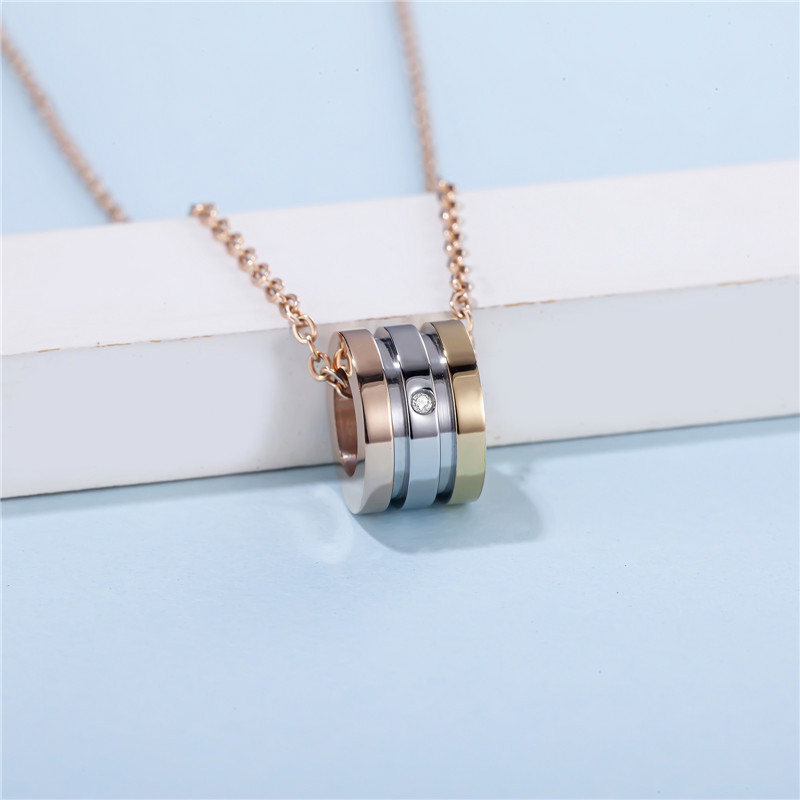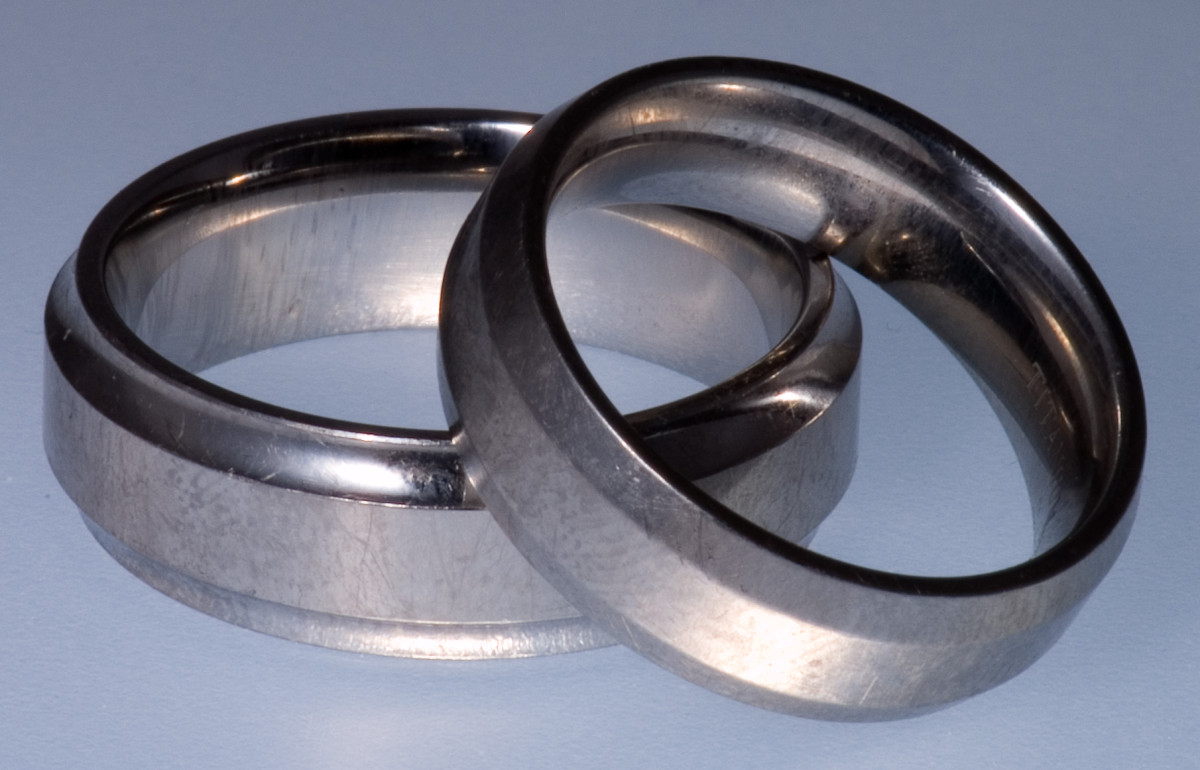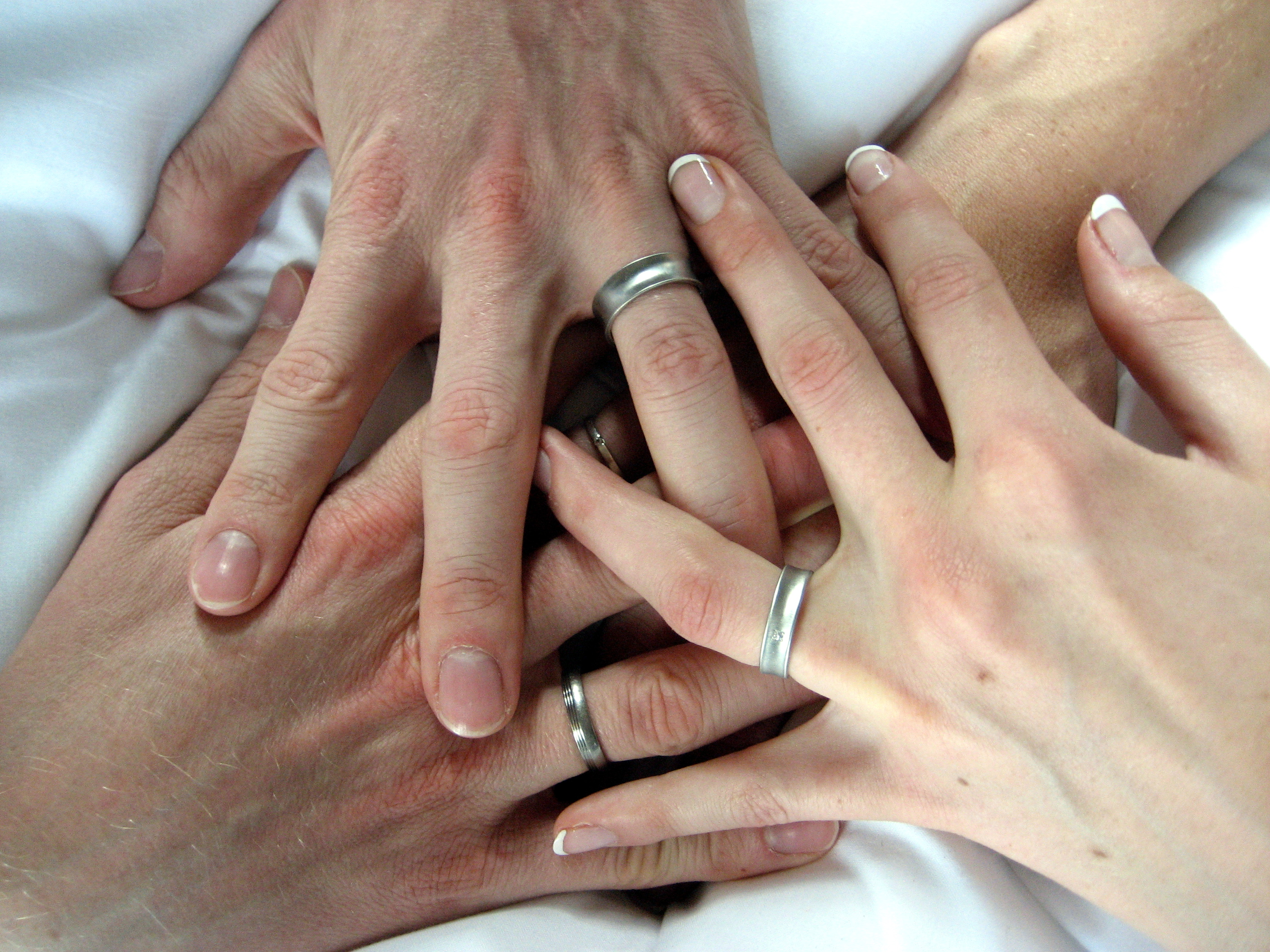
Titanium Jewelry: All About This Modern Alternative
 Titanium is an alternative metal used in various jewelry, from wedding bands to statement pendants. After becoming widely available in the 1990s, titanium jewelry has only increased in popularity. Jewelers have since found techniques to color titanium in shades like blue, purple, black, and more.
Titanium is an alternative metal used in various jewelry, from wedding bands to statement pendants. After becoming widely available in the 1990s, titanium jewelry has only increased in popularity. Jewelers have since found techniques to color titanium in shades like blue, purple, black, and more.
For reference, an “alternative metal” is any metal that isn’t one of the four precious metals: gold, silver, platinum, and palladium. Titanium and tungsten are the most common alternative metals.
Is titanium a good metal for jewelry? We’d certainly say so! But there are lots of factors to consider, so we’ve created this guide to help you understand the types of titanium jewelry, titanium’s pros and cons, how it compares to similar metals, and how much it costs.
First, you’ll need to know some basics about titanium.

What is Titanium?
Titanium is an element and metal often classified as a refractory metal. Refractory metals have a high melting point, hardness, heat-resistance, and resistance to wear.
German chemist Martin Heinrich Klaproth named titanium after the Titans, a group of pre-Olympian gods in Greek mythology known for being huge, strong, and powerful.
The metal is only found naturally as titanium dioxide. To get pure titanium, refiners typically use the Kroll process.
The Kroll process involves introducing chlorine, which converts titanium dioxide into titanium chloride. Then, the refiner adds magnesium or sodium to the titanium chloride to remove the chlorine. The result is pure titanium.
One of titanium’s top qualities is that it's lightweight yet very strong. In fact, it has the highest strength-to-weight ratio of any pure metal — it’s as strong as steel but only slightly heavier than aluminum.
Here’s a quick list of titanium’s properties:
Color: Silver- to grayish-white or gray
Melting Point: 1941 K; 1668 °C; 3034 °F
Density: 4.506 (4.11 when liquid)
Refractive Index: 2.61 (higher than most metals and even diamonds)
Resistant to corrosion and rust
Resistant to heat, water, and salt
These properties apply to pure titanium, but most titanium jewelry isn’t 100 percent pure. Instead, jewelers add other metals to create a titanium alloy.
 Pictured above: Anodized titanium | Image credit: Mauro Cateb; Creative Commons Attribution-Share Alike 3.0 Unported license
Pictured above: Anodized titanium | Image credit: Mauro Cateb; Creative Commons Attribution-Share Alike 3.0 Unported license
Types of Titanium
Shaping pure titanium jewelry is difficult for jewelers, as the metal is brittle — breaks under pressure instead of bending — at room temperature. Mixing in other metals makes it more flexible and malleable while maintaining titanium’s corrosion-resistance and strength.
The added metals in titanium alloys may be:
Aluminum
Vanadium
Zirconium
Nickel
Copper
Iron
Chromium
Cobalt
Niobium
Tantalum
Manganese
Molybdenum
Most titanium alloys mix in aluminum and vanadium, sometimes with a little iron oxide. A common mixture is 90 percent titanium, 6 percent aluminum, and 4 percent vanadium. One such example is Grade 5 titanium, one of the grades we’ll discuss next.
Titanium Grades
Titanium grades fall into two categories: titanium alloy grades and commercially pure (CP) grades.
Grades 1 to 4 are commercially pure, while titanium alloy grades go from 5 to 23 (sometimes more).
Despite the name “commercially pure,” Grades 1 to 4 titanium used in jewelry usually have vanadium and aluminum mixed in.
Here’s a breakdown of the commercially pure titanium grades:
Grade 1: Softest, most flexible, and easiest to shape; Has the least impurities or added metals; Highest impact toughness (which we’ll elaborate on later) and corrosion-resistance
Grade 2: Harder than Grade 1, near equally resistant to corrosion, easy to shape; Widely available, easy to use; Good impact strength & flexibility
Grade 3: Least commonly used but still valuable; Stronger than Grade 1 or Grade 2, similarly flexible, less easy to shape
Grade 4: Hardest and strongest but least flexible; High corrosion-resistance; Can have the most oxygen and/or iron content of any grade
The most common titanium alloy is Grade 5, also called Ti6Al4V, Ti-6Al-4V or Ti 6-4. It’s roughly 90 percent titanium, 6 percent aluminum, 4 percent vanadium, 0.25 percent iron, and 0.2 percent oxygen.
Grade 5 titanium is much stronger and more heat-resistant than Grades 1-4 while still being corrosion-resistant and easy to shape.
Certain grades may be better-suited to different types of jewelry. Grade 1 is great for titanium earrings, while Grade 5 is best for titanium jewelry used in body piercings.
Another titanium grade often used for body piercings is called “Aircraft Grade” titanium, which mixes in aluminum and vanadium, sometimes with tin as well. It has a whiter color and 3-times the strength of any of the Commercially Pure grades.
With the basics established, let’s get into the important titanium jewelry benefits and drawbacks to know.

Pros and Cons of Titanium Jewelry
All metals, titanium included, have advantages and disadvantages that are important to know before making your decision.
Pros of Titanium Jewelry
There are many advantages to titanium jewelry, including:
Higher scratch-resistance than precious metals
More affordable than precious metals
Won’t crack or shatter from hard impact
Lightweight
Very corrosion-resistant and rust-resistant
Won’t fade in color over time
Versatile colors and finishes available
Now, what are the disadvantages of titanium?
Cons of Titanium Jewelry
Some of the potential problems with titanium rings and other jewelry include:
Difficult to resize
Difficult to add traditional prong settings (unless prongs are a different metal)
Not as valuable for resale
Not as shiny as other metals
Next, let’s see how those pros and cons factor into titanium vs other jewelry metals.
 Pictured above: Titanium rings | Image credit: Earl, Flickr
Pictured above: Titanium rings | Image credit: Earl, Flickr
Titanium vs Similar Metals
You have lots of jewelry metals to choose from, so you’re probably curious how titanium fares in competition.
We’ll quell that curiosity by comparing titanium to its common competitors.
Titanium vs Stainless Steel
Is titanium jewelry better than stainless steel? In many ways, yes.
Roughly 75 percent of stainless steel grades contain nickel (including surgical steel) while most titanium doesn’t; therefore, titanium is more hypoallergenic than stainless steel.
Additionally, titanium is 3- to 4-times stronger than stainless steel. The two are close in hardness (scratch-resistance), with stainless steel ranking at 5.5 to 6.8.
Stainless steel has a greater tensile strength — how much it’ll stretch before breaking — but titanium has a higher strength-to-weight ratio.
Titanium is much more lightweight, 40 to 45 percent lighter, though this can be a matter of preference.
Price-wise, however, stainless steel is less expensive, though prices vary by the specific alloy, seller, and jewelry. Based on the value of the metals alone, stainless steel is currently valued at $1.00-$1.50 per kilogram and titanium value is $35-$50 per kilogram.
Both metals are long-lasting.
Titanium vs Sterling Silver
Like stainless steel, sterling silver (or 925 silver) is inferior to titanium in many ways.
First, titanium is more hypoallergenic. Most sterling silver jewelry is alloyed with copper or zinc, but nickel (the #1 jewelry allergen) may be added to help maintain the silver’s luster and firmness.
Second, titanium alloys are much easier to make and work with than silver alloys. While additional metals make silver stronger, some (namely copper) will cause faster tarnishing.
Speaking of tarnishing, titanium is much more tarnish- and corrosion-resistant than sterling silver. Titanium is also much stronger and more durable while being lighter-weight.
One point for sterling silver, however, is resizing. It’s much easier to resize sterling silver wedding bands than titanium wedding bands.
The other benefit of sterling silver over titanium is price, as sterling silver is generally lower in price than titanium. However, prices fluctuate and titanium can sometimes be more affordable than silver.
 Pictured above: Sterling silver ring with cubic zirconia
Pictured above: Sterling silver ring with cubic zirconia
Titanium vs Tungsten
Unlike the last two metals, tungsten is a much closer competitor to titanium.
Let’s look at strength first. Tungsten and tungsten carbide are harder (7.5 for tungsten, 8 to 9 for tungsten carbide) and have greater tensile strength than titanium. But titanium has a greater impact strength (resistance to breaking from a hard blow) and is lighter-weight.
Titanium jewelry colors are more versatile; tungsten jewelry only comes in black, white, and the natural silver-gray. However, tungsten has a higher shine that lasts for longer.
The price of tungsten and titanium jewelry is similar, though titanium is slightly more affordable.
Titanium vs Platinum
Platinum and sterling silver are the only precious metals in this comparison list, but “precious” doesn’t automatically mean better.
Titanium and platinum do have some qualities in common. They’re both hypoallergenic, durable, and easy to maintain.
The first difference is appearance. Like tungsten, platinum cannot be anodized, so the color options are more limited. In their natural forms, platinum has a lighter, silvery-white color than titanium. Neither metal will fade in color over time, but platinum’s luster will dull while titanium’s won’t.
In terms of strength, titanium is about 7-times stronger than platinum while being one-third of the weight. Platinum is incredibly heavy.
Looking at hardness, platinum ranks at 4 to 4.5, so a platinum ring will get scratched more easily than a titanium ring. However, it’s easier to remove scratches from platinum than titanium.
Titanium often beats out platinum’s tensile strength, but it can depend on the titanium grade. The two have comparable impact strength.
Jewelry made from either metal should last a lifetime.
Platinum is much harder to come by and thus more expensive than titanium. In fact, platinum is among the most expensive wedding ring metals.
Speaking of price…
 Pictured above: Titanium wedding band (left) and white gold wedding band (right) | Image credit: Abulic Monkey from Birmingham, UK; Creative Commons Attribution 2.0 Generic license
Pictured above: Titanium wedding band (left) and white gold wedding band (right) | Image credit: Abulic Monkey from Birmingham, UK; Creative Commons Attribution 2.0 Generic license
Titanium Jewelry Prices
If you’ve browsed for titanium jewelry online, you may have wondered: why are titanium rings cheap? Titanium rings vary in price from $20 to nearly $10,000, but many are quite low in price because titanium is a fairly abundant metal.
Precious metals like platinum or gold are valuable because they’re rare, and that scarcity translates to steep price points. Titanium is only pricier than aluminum and steel. That said, the resale value of titanium is considerably lower than that of precious metals.
Titanium jewelry for body piercings is usually around $40, with added gemstones bringing higher prices.
Here at Jewelry Auctioned, you can find titanium necklaces for around $10 and even gold-plated titanium necklaces for under $30. Our titanium rings range from $10 to around $130. Generally, titanium rings cost $10 to $400, though added gemstones can up the price.
Are Titanium Rings Safe?
Good news: titanium rings and other jewelry are completely safe.
But is titanium jewelry good for sensitive skin? Yep, titanium jewelry is safe for sensitive skin or those prone to contact dermatitis. Despite rumors about titanium jewelry allergies or hypersensitivity, a decade of research from The Mayo Clinic found no reactions to titanium.
Is titanium jewelry good for piercings? Absolutely! Titanium and surgical steel are the most common metals used for initial body piercings.
Can titanium rings be cut off? Yes, though usually not with a normal ring cutter. Depending on the ring thickness and titanium grade, doctors may need to use a bolt cutter to cut off a titanium ring in an emergency.
Before we wrap up, we’ll go over how long you can expect titanium jewelry to last.
Titanium Jewelry Durability & Maintenance
How long does titanium jewelry last? With proper care, titanium jewelry will last a lifetime. Since resizing titanium is difficult to impossible, most reputable jewelers will offer a lifetime warranty so you can have your titanium ring replaced if your finger changes sizes or the ring needs to be cut off in an emergency.
Proper care means knowing how to clean your jewelry, when to remove it, and how to store it.
Can you shower with titanium jewelry? Yes, unless it’s anodized. Titanium won’t react with water or your body’s natural chemistry. However, titanium can be harmed by harsh chemicals like chlorine, so it’s best to remove it before swimming.
It’s also best to remove titanium jewelry before engaging in extreme activities like operating heavy equipment.
For anodized titanium jewelry, wipe it down with a soft, clean cloth after each wear and store it in a resealable plastic bag (like a Ziploc). Keep anodized titanium away from bleach, chlorine, and harsh beauty products like perfume or hairspray.
The safest way to clean titanium jewelry is by soaking it in a mixture of warm water and mild soap (like dish soap or Dove soap) for around 5 minutes. If there’s dirt or debris remaining, gently wipe it off with a cloth or your fingers. Then, rinse off any soap residue and dry the jewelry with a soft cloth.
Store titanium jewelry in a fabric pouch or fabric-lined box separately from other jewelry pieces.
Try Titanium Jewelry Today!
Titanium may not be as recognizable or famous as gold or silver, but this metal offers just as much if not more. With style, durability, and various color options at an affordable price point, what’s not to love?
Search the Fashion Encyclopedia
Related Auctions
Related Articles
A simple guide for understanding gold hallmarks, how to identify them and the methods for testing gold purity.
13th Jun 2019
Tree of life jewelry carries sacred meanings in various cultures and religions. Learn the origin, meanings, and styles behind tree of life jewelry in this guide.
10th Apr 2019
Latest Articles
Learn all about tungsten jewelry - from its history and uses to its durability and care. By the end of our guide, you’ll know if tungsten is right for you!
7th Feb 2023
Thinking about adding some timeless white gold jewelry to your fine accessories collection? Here’s all there is to know about sophisticated white gold!
29th Jan 2023
Gold jewelry comes in many shades, but yellow gold is the most popular, classic option. Learn what yellow gold means, the types of gold jewelry, and what to know before buying yellow gold jewelry.
26th Jan 2023




